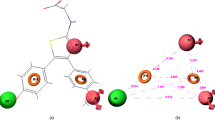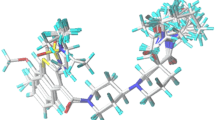Abstract
Metabolic problems lead to numerous failures during clinical trials, and much effort is now devoted to developing in silico models predicting metabolic stability and metabolites. Such models are well known for cytochromes P450 and some transferases, whereas less has been done to predict the activity of human hydrolases. The present study was undertaken to develop a computational approach able to predict the hydrolysis of novel esters by human carboxylesterase hCES2. The study involved first a homology modeling of the hCES2 protein based on the model of hCES1 since the two proteins share a high degree of homology (≅73%). A set of 40 known substrates of hCES2 was taken from the literature; the ligands were docked in both their neutral and ionized forms using GriDock, a parallel tool based on the AutoDock4.0 engine which can perform efficient and easy virtual screening analyses of large molecular databases exploiting multi-core architectures. Useful statistical models (e.g., r 2 = 0.91 for substrates in their unprotonated state) were calculated by correlating experimental pKm values with distance between the carbon atom of the substrate’s ester group and the hydroxy function of Ser228. Additional parameters in the equations accounted for hydrophobic and electrostatic interactions between substrates and contributing residues. The negatively charged residues in the hCES2 cavity explained the preference of the enzyme for neutral substrates and, more generally, suggested that ligands which interact too strongly by ionic bonds (e.g., ACE inhibitors) cannot be good CES2 substrates because they are trapped in the cavity in unproductive modes and behave as inhibitors. The effects of protonation on substrate recognition and the contrasting behavior of substrates and products were finally investigated by MD simulations of some CES2 complexes.






Similar content being viewed by others
References
Vistoli G, Pedretti A, Testa B (2008) Assessing drug-likeness—what are we missing? Drug Discov Today 13:285–294
Krämer SD, Testa B (2008) The biochemistry of drug metabolism—an introduction. Part 6: Inter-individual factors affecting drug metabolism. Chem Biodivers 5:2465–2578
Krämer SD, Testa B (2009) The biochemistry of drug metabolism—an introduction. Part 7: Intra-individual factors affecting drug metabolism. Chem Biodivers 6:1477–1660
Testa B, Krämer SD (2006) The biochemistry of drug metabolism—an introduction. Part 1: Principles and overview. Chem Biodivers 3:1053–1101
Czodrowski P, Kriegl JM, Scheuerer S, Fox T (2009) Computational approaches to predict drug metabolism. Exp Opin Drug Metab Toxicol 5:15–27
Testa B, Krämer SD (2007) The biochemistry of drug metabolism–an introduction. Part 2: Redox reactions and their enzymes. Chem Biodivers 4:257–405
Stjernschantz E, Vermeulen NP, Oostenbrink C (2008) Computational prediction of drug binding and rationalisation of selectivity towards cytochromes P450. Exp Opin Drug Metab Toxicol 4:513–527
Edmondson DE, Mattevi A, Binda C, Li M, Hubálek F (2004) Structure and mechanism of monoamine oxidase. Curr Med Chem 11:1983–1993
Carballeira JD, Quezada MA, Alvarez E, Sinisterra JV (2004) High throughput screening and QSAR-3D/CoMFA: useful tools to design predictive models of substrate specificity for biocatalysts. Molecules 9:673–693
Testa B, Krämer SD (2008) The biochemistry of drug metabolism—an introduction. Part 4: Reactions of conjugation and their enzymes. Chem Biodivers 5:2171–2336
Smith PA, Sorich MJ, Low LS, McKinnon RA, Miners JO (2004) Towards integrated ADME prediction: past, present and future directions for modelling metabolism by UDP-glucuronosyltransferases. J Mol Graph Model 22:507–517
Najmanovich RJ, Allali-Hassani A, Morris RJ, Dombrovsky L, Pan PW, Vedadi M, Plotnikov AN, Edwards A, Arrowsmith C, Thornton JM (2007) Analysis of binding site similarity, small-molecule similarity and experimental binding profiles in the human cytosolic sulfotransferase family. Bioinformatics 23:104–109
Sipilä J, Taskinen J (2004) CoMFA modeling of human catechol O-methyltransferase enzyme kinetics. J Chem Inf Comput Sci 44:97–104
Soffers AE, Ploemen JH, Moonen MJ, Wobbes T, van Ommen B, Vervoort J, van Bladeren PJ, Rietjens IM (1996) Regioselectivity and quantitative structure-activity relationships for the conjugation of a series of fluoronitrobenzenes by purified glutathione S-transferase enzymes from rat and man. Chem Res Toxicol 9:638–646
Vistoli G, Pedretti A, Mazzolari A, Bolchi C, Testa B (2009) Influence of ionization state on the activation of temocapril by hCES1: a molecular-dynamics study. Chem Biodivers 6:2092–2100
Vistoli G, Pedretti A, Mazzolari A, Testa B (2010) In silico prediction of human carboxylesterase-1 (hCES1) metabolism combining docking analyses and MD simulations. Bioorg Med Chem 18:320–329
Testa B, Mayer JM (2003) Hydrolysis in drug and prodrug metabolism–Chemistry, Biochemistry and Enzymology. Wiley-VCH, Weinheim
Hatfield JM, Wierdl M, Wadkins RM, Potter PM (2008) Modifications of human carboxylesterase for improved prodrug activation. Exp Opin Drug Metab Toxicol 4:153–165
Ettmayer P, Amidon GL, Clement B, Testa B (2004) Lessons learned from marketed and investigational prodrugs. J Med Chem 47:2393–2404
Testa B (2009) Prodrugs: bridging pharmacodynamic/pharmacokinetic gaps. Curr Opin Chem Biol 13:338–344
Testa B, Krämer SD (2009) The biochemistry of drug metabolism—an introduction. Part 5. Metabolism and bioactivity. Chem Biodivers 6:591–684
Imai T (2006) Human carboxylesterase isozymes: catalytic properties and rational drug design. Drug Metab Pharmacokinet 21:173–185
Hosokawa M (2008) Structure and catalytic properties of carboxylesterase isozymes involved in metabolic activation of prodrugs. Molecules 13:412–431
Sanghani SP, Sanghani PC, Schiel MA, Bosron WF (2009) Human carboxylesterases; an update on CES1, CES2 and CES3. Protein Pept Lett 16:1207–1214
Satoh T, Hosokawa M (1998) The mammalian carboxylesterases: from molecules to functions. Annu Rev Pharmacol Toxicol 38:257–288
Yang D, Pearce RE, Wang X, Gaedigk R, Wan YJ, Yan B (2009) Human carboxylesterases HCE1 and HCE2: ontogenic expression, inter-individual variability and differential hydrolysis of oseltamivir, aspirin, deltamethrin and permethrin. Biochem Pharmacol 77:238–247
Testa B, Krämer SD (2007) The biochemistry of drug metabolism—an introduction. Part 3: Reactions of hydrolysis and their enzymes. Chem Biodivers 4:2031–2122
Satoh T, Hosokawa M (2006) Structure, function and regulation of carboxylesterases. Chem Biol Interact 162:195–211
Pindel EV, Kedishvili NY, Abraham TL, Brzezinski MR, Zhang J, Dean RA, Bosron WF (1997) Purification and cloning of a broad substrate specificity human liver carboxylesterase that catalyzes the hydrolysis of cocaine and heroin. J Biol Chem 272:14769–14775
Morris GM, Goodsell DS, Halliday RS, Huey R, Hart WE, Belew RK, Olson AJ (1998) Automated docking using a Lamarckian genetic algorithm and and empirical binding free energy function. J Comput Chem 19:1639–1662
Donald J, Martonosi M (2006) An efficient, practical parallelization methodology for multicore architecture simulation. IEEE Comput Architect Lett 5:2
Pedretti A, Villa L, Vistoli G (2002) VEGA: a versatile program to convert, handle and visualize molecular structure on Windows-based PCs. J Mol Graph Model 21:47–49
Gropp W, Thakur R (2007) Thread safety in an MPI Implementation: requirements and analysis. Parallel Comput 9:595–604
Dyrløv Bendtsen J, Nielsen H, Von Heijne G, Brunak S (2004) Improved prediction of signal peptides: SignalP 3.0. J Mol Biol 340:783–795
Arnold K, Bordoli L, Kopp J, Schwede T (2006) The SWISS-MODEL Workspace: a web-based environment for protein structure homology modeling. Bioinformatics 22:195–201
Nishi K, Huang H, Kamita SG, Kim IH, Morisseau C, Hammock BD (2006) Characterization of pyrethroid hydrolysis by the human liver carboxylesterases hCE-1 and hCE-2. Arch Biochem Biophys 445:115–123
Ross MK, Borazjani A, Edwards CC, Potter PM (2006) Hydrolytic metabolism of pyrethroids by human and other mammalian carboxylesterases. Biochem Pharmacol 71:657–669
Takai S, Matsuda A, Usami Y, Adachi T, Sugiyama T, Katagiri Y, Tatematsu M, Hirano K (1997) Hydrolytic profile for ester- or amide-linkage by carboxylesterases pI 5.3 and 4.5 from human liver. Biol Pharm Bull 20:869–873
Taketani M, Shii M, Ohura K, Ninomiya S, Imai T (2007) Carboxylesterase in the liver and small intestine of experimental animals and human. Life Sci 81:924–932
Imai T, Taketani M, Shii M, Hosokawa M, Chiba K (2006) Substrate specificity of carboxylesterase isozymes and their contribution to hydrolase activity in human liver and small intestine. Drug Metab Dispos 34:1734–1741
Sanghani SP, Quinney SK, Fredenburg TB, Davis WI, Murry DJ, Bosron WF (2004) Hydrolysis of irinotecan and its oxidative metabolites, 7-ethyl-10-[4-N-(5-aminopentanoic acid)-1-piperidino] carbonyloxycamptothecin and 7-ethyl-10-[4-(1-piperidino)-1-amino]-carbonyloxycamptothecin, by human carboxylesterases CES1A1, CES2, and a newly expressed carboxylesterase isoenzyme, CES3. Drug Metab Dispos 32:505–511
Godden JW, Xue L, Bajorath J (2000) Classification of biologically active compounds by median partitioning. J Chem Inf Comput Sci 40:163–166
Testa B, Carrupt PA, Gaillard P, Billois F, Weber P (1996) Lipophilicity in molecular modeling. Pharm Res 13:335–343
Phillips JC, Braun R, Wang W, Gumbart J, Tajkhorshid E, Villa E, Chipot C, Skeel RD, Kalé L, Schulten K (2005) Scalable molecular dynamics with NAMD. J Comput Chem 16:1781–1802
Kawabata T (2003) MATRAS: a program for protein 3D structure comparison. Nucleic Acids Res 31:3367–3369
Bencharit S, Edwards CC, Morton CL, Howard-Williams EL, Kuhn P, Potter PM, Redinbo MR (2006) Multisite promiscuity in the processing of endogenous substrates by human carboxylesterase 1. J Mol Biol 363:201–214
Streit TM, Borazjani A, Lentz SE, Wierdl M, Potter PM, Gwaltney SR, Ross MK (2008) Evaluation of the ‘side door’ in carboxylesterase-mediated catalysis and inhibition. Biol Chem 389:149–162
Wierdl M, Morton CL, Nguyen NK, Redinbo MR, Potter PM (2004) Molecular modeling of CPT-11 metabolism by carboxylesterases (CEs): use of pnb CE as a model. Biochemistry 43:1874–1882
Eckert F, Klamt A (2006) Accurate prediction of basicity in aqueous solution with COSMO-RS. J Comput Chem 27:11–19
Author information
Authors and Affiliations
Corresponding author
Electronic supplementary material
Below is the link to the electronic supplementary material.
Rights and permissions
About this article
Cite this article
Vistoli, G., Pedretti, A., Mazzolari, A. et al. Homology modeling and metabolism prediction of human carboxylesterase-2 using docking analyses by GriDock: a parallelized tool based on AutoDock 4.0. J Comput Aided Mol Des 24, 771–787 (2010). https://doi.org/10.1007/s10822-010-9373-1
Received:
Accepted:
Published:
Issue Date:
DOI: https://doi.org/10.1007/s10822-010-9373-1




